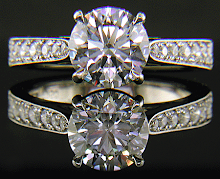And so, I bring you...... Alexandrite, The True Changer !
Alexandrite is a unique gemstone that displays a phenomenon called Photochroism or Color-Change effect. Due to the popularity of this particular feature, this is also known as the Alexandrite effect even when seen in other types of gemstones.
A fine Alexandrite will display one color under natural daylight and a different color under artificial or incandescent light.
Alexandrite responds specifically to different wavelengths of light, resulting in a range of hues, depending on the quality of the gem.
Under daylight, Alexandrite can exhibit lush green hues, as well as greens modified by blue to create a deep teal hue and yellowish-greens modified by brown.
Under incandescent light, Alexandrite may display a dark red hue, a purplish-Red color or a brownish-pink. The deeper and more vibrant the colors, the finer the gem. And....the stronger the amount of color change, the rarer the gem.
The strength of color change combined with the purity and vibrancy of the hues are THE most important characteristics in determining the value of natural Alexandrite.
Alexandrite also has a rich history that is tied to Russian Royalty. In 1830, a poor peasant laborer discovered this unusual gem in a mine deep beneath the Ural Mountains of Russia.
Fascinated with the way the gem turned from green to red, he and others called it the Christmas Stone.
This was also the time when a young Russian Tsarevitch, Alexander II, was celebrating his 12th birthday. As red and green were also the colors of the Tsarist Court, the stone was swiftly renamed Alexandrite.
Unfortunately, the major Russian sources of alexandrite were depleted by the early 1900s. More recently, deposits of alexandrite have been found in the gem-rich regions of Brazil. The finest Brazilian stones exhibit deep colors and exceptional clarity which rival the earlier Russian stones. It is the beauty of these fine Brazilian alexandrites that has generated a renewed interest in this phenomenal gemstone.
And if you did not already know, Alexandrite is considered a birthstone for those born in the month of June. Imagine that......a gem to commemorate your own birthday !
I love working with rare and beautiful gemstones like Alexandrite. The layout shown above is a group of gemstones I researched and located for a specific client. She chose the gorgeous cushion cut gem, second from the left.
If you would like to purchase a fine quality Alexandrite and perhaps have a jewel custom designed with such a rare beauty, please send me an email .
Additional photos of fine gems and jewelry can be found at Bijoux Extraordinaire











2 comments:
Love this post! This is a really good blog wish more people would read this, you offer some really good suggestions on best Alexandrite Gemstone. Thanks for sharing!
Its really hard to find real alexandrite in the market. Many says they sell the natural one but most if them are selling the lab created version. Found this real alexandrite guide talks about how to spot genuine alexandrite.
Post a Comment